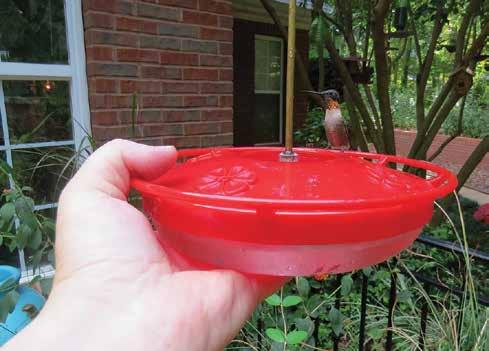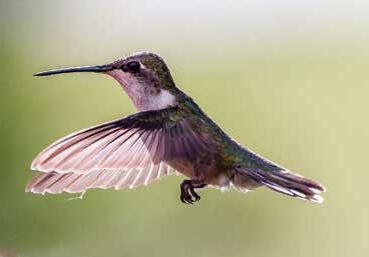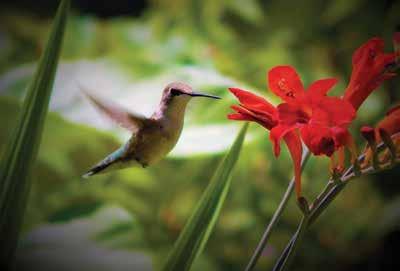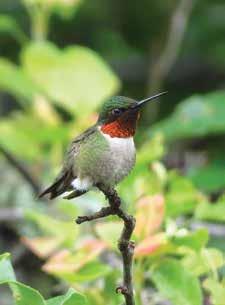
3 minute read
Simple steps can attract to your home Hummingbirds
By Kendra Carlson
Watching a hummingbird is enchanting. Their tiny size and incredible speed make them a natural wonder. Flapping their wings an estimated 70 times per second, they can move in every direction, or simply float majestically in midair.
You may have observed hummingbirds in the wild, but you can increase your chances of seeing these delicate dynamos at home. You can even get one to land on your hand, with patience and persistence. However, before that can happen, you need to transform your backyard into a hummingbird haven.
Hummingbirds must eat once every 10 to 15 minutes and visit between 1,000 and 2,000 flowers per day. When you provide a safe, reliable food source, it's like putting out a welcome mat for hummingbirds.

Some flowering plants are particularly attractive to hummingbirds, such as trumpet honeysuckle, bee balm and sage. A hummingbird feeder is a must-have and one of the most effective ways to consistently entice and encourage hummingbirds to visit your yard.

Keep in mind, not all feeders are created equal. A “high-rise” feeder is designed with elevated perches to make hummingbirds feel safe and comfortable, which encourages them to consistently return. Look for one that doesn’t drip and attract ants and bees. Traditional sugar water can be mixed to fill the feeder, then hang it in a tree, patio or garden spaces.
To attract hummingbirds
It's easy to make a few common mistakes when you start welcoming hummingbirds to your yard. Here’s a few tips: until you're sitting right next to the feeder.
• Be conscious of beneficial insects. Small insects are an important part of a hummingbird's diet, providing essential protein to complement the nectar they drink. Try using manual or natural insect control in the afternoon when insect populations decrease.
• Do provide a water feature. Hummingbirds adore bathing. If you add a drip fountain or mister to your yard, they'll bask in the wet wonder.
• Don't put anything but plain water into “ant moats.” Water alone will stop ants in feeders with this feature. Other birds may stop and take a drink from the liquid in the moat, so never use any type of repellent or additive to the water.
• Do check feeders regularly. Check at least bi-weekly to ensure a steady supply of fresh food. Clean the feeder as needed with one part white vinegar to four parts water.
• Don't add red coloring to food. While hummers are attracted to red, adding dye to their food is unnecessary and could be harmful to their health.
• Do hang feeders in the shade. Too much sunshine and warmth can cause fermentation of sugar-based liquids. To prevent this, always hang feeders in the shade.
Once the bird is comfortable having you nearby, you can try holding the feeder or cupping your hand to use as a perch underneath the feeding ports. This can take several weeks, but with consistency and patience, you'll be able to enjoy a close-up encounter with the uniquely exquisite hummingbird. D

A bird in the hand
Once your feeder is in regular use, it's exciting to try to get one to land on your hand. Sit near your feeder when typically in use. Remain still, as the birds must realize you're not a threat. Repeat this several times a day for a few days, wearing the same clothing. Move a little closer each day
Hummingbird Nectar Recipe
The standard formula for nectar is 4 parts water to 1 part table sugar. For example, to make enough to fill an 8-12 oz. feeder you would use:
1 cup water
¼ cup sugar
Pour the sugar into warm tap water and stir until dissolved. Boiling the mixture is fine, but not necessary. You can make extra and store it in the fridge to make the next few fill-ups quick and easy. Clean the feeder and replace the nectar every three to five days — sooner if the nectar gets a little cloudy.
As tempting as it may be, you should never put anything other than sugar and water into a hummingbird feeder.
Never add the following ingredients when making nectar at home:
Red food coloring. While hummers are attracted to the color red, adding red dye to their food is unnecessary and, depending on the chemical makeup of the dye, potentially harmful to their health. Most hummingbird feeders are already predominantly red so as to entice hummers to visit. If you think yours is not red enough, simply add a red ribbon to the hanger or place your feeder near a colorful flower bed.
Artificial sweeteners. Hummers do not need to watch their sugar intake, so never use any sweetener other than regular sugar when making nectar.
Honey or molasses. When mixed with water, honey and molasses create a great breeding ground for potentially fatal bacteria and mold to grow.
Chile oil or powder. While not harmful to hummers if ingested, chilies are not part of the normal hummingbird diet and therefore should be avoided. Hummers are strictly sweet nectar and insect-eating creatures — anything else might even cause them to quit using your feeder.









